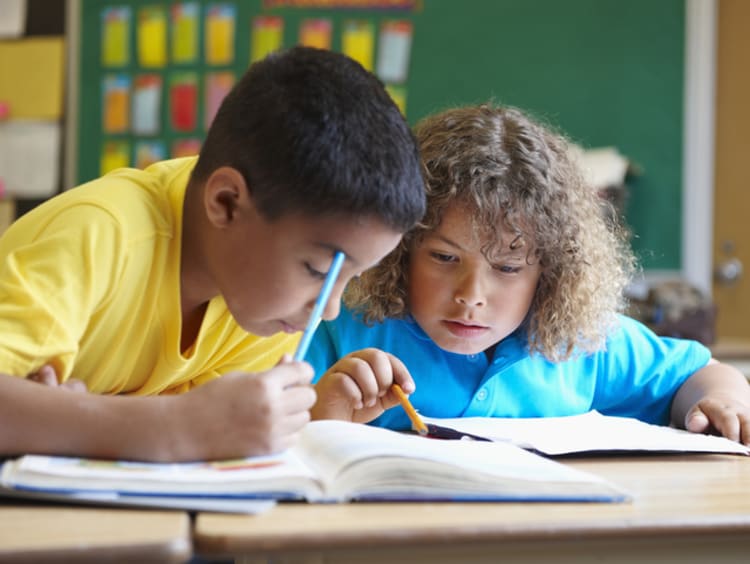Benefits of Implementing a Buddy System in Schools

When K–12 students come to class on the first day of school, they all share a similar hope. That hope is to find a friend. The search often begins as soon as they arrive at school and sit in their seats.
However, some students may find this more difficult because of poorly developed social, self-regulation and communication skills. These skill gaps can arise from disabilities or from limited social opportunities, such as in the isolation experienced during the pandemic.1 Children with disabilities are a population vulnerable to bullying and may be targeted due to a lack of peer support.2
“All children want to feel seen, understood, and valued as classroom community members,“ GCU assistant professor Jennifer Jakobi shared. “Teachers are finding ways to include diverse students in general education classrooms, including creating universally designed lesson plans (UDL) and providing accommodations — and this is just the start. There is always more we can do so that students with disabilities can flourish,” Jakobi reports.
In This Article:
- What Is the Buddy System?
- Different Kinds of Buddy Activities for Elementary School and Beyond
- Getting Started With Your Buddy System in Schools
- Why Is the Buddy System in Education a Good Idea?
What Is the Buddy System?
You might be wondering, What is the buddy system? The peer buddy system in education can address the needs of students with low social and communication skills to establish sibling-like friendships. Both disabled and non-disabled students can show remarkable growth in their academic, social and emotional skills by joining a peer buddy program in their learning community.1 The peer buddy system is a two-way support system where both buddies benefit from developing empathy, understanding and acceptance of differences. They also learn valuable life skills, such as patience, cooperation and communication.3
As a pre-service teacher in the College of Education, I am invested in learning ways to meet the needs of diverse learners in my classroom. I myself was in a peer buddy program during the first and second grades. My school had a program called Book Buddies. All of us elementary school students were paired up with one to two middle school students. We would all meet up in the library, and they would read to me, or I would read to them. It was — and still is — one of my favorite memories from early elementary school, and it was a great way to connect younger students with the upper grades.
This is just one example of a buddy system in schools — let us examine a few more!
Different Kinds of Buddy Activities for Elementary School and Beyond
A school can adopt several formats of the peer buddy program, depending on the needs of its diverse learning community. Some formats include:
- Pair upper elementary or middle school students with younger students in pre-K through first grade. Examples of activities can include reading or being recess buddies.1
- “Inclusive education” pairs students with exceptionalities with typically developing peers in an inclusive classroom. This can be helpful for peer academic support, structured play and planned classroom activities.3
- “Reverse inclusion” pairs neurotypical students and students with exceptionalities in a self-contained classroom for planned periods and activities. Students in self-contained classrooms often have little to no interaction with their non-disabled peers. Example activities can include playing games, recreational sports and academic support.
- A buddy program for after-school sports can be an interactive way for students to participate non-competitively in sports. A sports buddy system allows students of all abilities to have fun and play sports together without the pressure of a vision board. Programs can offer buddy baseball, basketball and kickball.4 Additionally, there are a variety of nationally recognized inclusive sports organizations schools can partner with, such as Unified Sports and Special Olympics.5
Getting Started With Your Buddy System in Schools
The first step is establishing a Buddy Program Planning Committee to plan activities focused on the school's mission and student needs. This planning committee can consist of the administration staff, teachers and students. The planned activities may include academic tutoring, recess support, recreational sports, games and structured play activities.
Next, plan to provide training to buddies. Neurotypical buddies should be provided training on how to be good role models, how to communicate with someone who has an exceptionality, and how to assist with planning activities.6 Professor Jakobi emphasizes, “Neurotypical students should be given time to reflect after buddy activities to process what they learned about their buddy with an exceptionality and how they can grow in their friendship.”
Why Is the Buddy System a Good Idea?
Inclusion takes planning and comes in many shapes and forms in schools. Planning and implementing a buddy system in education can significantly enhance the school day for students with exceptionalities and contribute to the human flourishing of everyone involved. Now that you know the benefits and how to create a buddy system, try it at your school!
If you are interested in starting or advancing your career in education, learn more about teaching degrees at Grand Canyon University offered through the College of Education. Complete the form on this page to learn more.
1 Robles, G. (2022, Aug. 11). How a Buddy Program Can Foster SEL. Edutopia. Retrieved Feb. 24, 2024.
2 Assistant Secretary for Public Affairs (ASPA). (2019, Sept. 24). Bullying and Youth with Disabilities and Special Health Needs. StopBullying.gov. Retrieved Feb. 24, 2024.
3 Jain, H. (2023, June 24). Buddy System in Inclusive Education. Prep with Harshita. Retrieved Feb. 24, 2024.
4 Surprise, AZ - Official Website. (2023). Buddy Sports. Surpriseaz.gov. Retrieved Feb. 24, 2024.
5 Special Olympics. (2018, Aug. 2). Mission. SpecialOlympics.org. Retrieved Feb. 24, 2024.
6 Dobres J., and Posada, L. (2021, Jan. 1). Reverse Inclusion and the Use of Peer Buddies to Teach Social Skills in a Public School Setting. Autism Spectrum News. Retrieved Feb. 24, 2024.
Approved by the executive assistant for the College of Education on June 4, 2024.
The views and opinions expressed in this article are those of the author’s and do not necessarily reflect the official policy or position of Grand Canyon University. Any sources cited were accurate as of the publish date.


